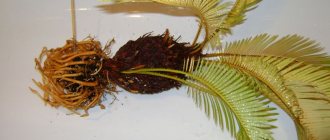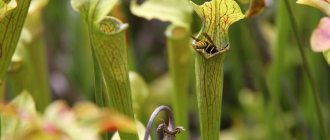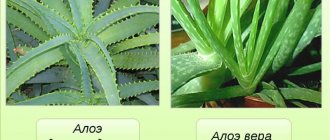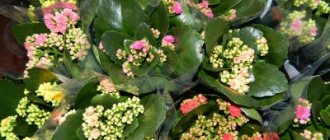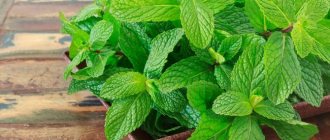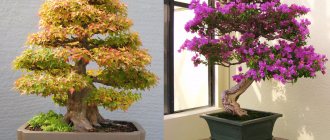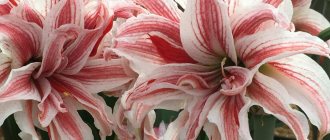According to the science of Feng Shui, indoor plants can influence us on an energetic level; they are ways of sucking out a person’s vitality and energy. Experts in the field of this science do not advise keeping flowers that are sick or withered in the house. Don't keep plants that don't sprout.
If, while caring for a flower, you notice that it cannot come to life in any way, this means that you will need to throw away the plant, as it has begun to spread negative energy.
If the plant was healthy all the time, and then, for no apparent reason, began to shed its leaves, then this means that your plant has taken on negative energy, thereby protecting your home.
The most harmful flowers according to the science of Feng Shui:
- Cacti. They are considered poisonous plants, according to the science of Feng Shui, since cacti are prickly, they contribute to quarrels and make people “thorny.” The sharp needles of a cactus can scare away a woman's betrothed.
- Monstera is considered an energy vampire, despite the fact that it has an attractive appearance.
- Yucca and sansevieria are considered “crybaby plants” and take energy from a person.
- Lilies are very beautiful indoor flowers, but you should not place them near where you sleep, they are energy vampires.
What folk items say about plants
When choosing a houseplant, you need to pay attention to how you feel; if you don’t like the flower, then you should not buy it and bring it home. You should buy those plants that will bring you positive emotions and, looking at which you will feel light and relaxed.
At the moment, there are a lot of folk signs regarding indoor plants:
- If a girl has a cactus in her house, then you should not count on a successful marriage. But only if the cactus is in the bedroom. Also, it is better for married women not to keep a cactus, since it is believed that a cactus in the house is the reason for the alcoholism of the man in the family.
- If you are given a palm tree, do not bring it into your home, otherwise it can bring great misfortune.
- Ivy can be dangerous for women. According to legends, ivy escapes from men's houses and does not allow anyone near its owner.
- Violet brings bad luck to young girls in love.
There are a lot of signs about flowers, some positive and some negative. For some, a flower can bring good luck, while for others it can be symbolized with grief. You shouldn’t believe in omens; you need to choose a flower according to your inner convictions. If you like the plant, then you should definitely buy it.
Poisonous indoor plants
Some indoor plants can pose a danger to human life and to small children, so before buying a plant, you should first read its description.
Some plants were brought to us in Russia from the tropics and are not accustomed to such an environment, so it will be a natural process for the plant to protect itself by releasing toxic substances.
The most poisonous plants that you should not keep at home:
- Dieffenbachia is a beautiful plant with large leaves, despite this it is very poisonous, as it contains a crystal of calcium oxalate and salin. The juice should never be consumed, otherwise your tongue may become swollen and, due to the high heart rate, you may experience anaphylactic shock. If the juice gets on human skin, it can cause severe burns.
- Aglaonema is a poisonous houseplant that contains the poison alkaloid aroin. You may feel irritation when you touch the plant. If ingested, it can cause vomiting or even damage to the central nervous system, so you should be careful with this plant.
- Adenium thick is a poisonous plant, the juice of which can cause intoxication if it enters the human body.
- Euphorbia - the juice of this flower can be very dangerous for humans and cause severe redness and burning of the skin. If the juice gets into the eyes, it can cause temporary loss of vision. If ingested, it may cause symptoms such as dizziness, vomiting and poor circulation.
- Scindapsus is a houseplant that, upon contact with humans, can cause skin dermatitis.
- Rhododendron Sims is very poisonous to humans and can cause convulsions if ingested.
- Hydrangea is a poisonous houseplant that causes sweating, intestinal pain and nausea.
- Clivia is a beautiful houseplant, but be careful when handling the leaves of the plant, it contains poison, which, if entering the human body, can cause diarrhea and vomiting, and sometimes even paralysis.
- Cycas contains a toxin that, if it comes into contact with your pet, can poison it and lead to the death of the pet. You should keep such a plant away from your pet, it is just as dangerous as Zamia.
- Gloriosa is a houseplant that can cause kidney disease and at the same time impair blood clotting. If you are poisoned by this plant, it first manifests itself in the form of diarrhea, nausea and vomiting.
When purchasing another flower, we do not even know about some of the harmful properties of indoor plants, and then suddenly we notice emerging health problems. If a small child or animals live in the house, then you need to pay special attention to the choice of indoor flowers and plants in order to protect their livelihoods. Some types of plants contain poison in their sap or release harmful substances into oxygen.
In addition to plants that are not recommended to be kept at home, some flowers have an adverse effect on the human body. In this case, you need to choose the right location for the future green resident, without placing it in the bedroom or, conversely, in the kitchen.
There are a huge number of disputes and disagreements about dangerous plants in the house. All the sayings are mixed with various signs that can ultimately confuse a novice gardener. In this article we will look at plants with which you need to be careful and be aware of the likely consequences for the body and for energy.
Landing rules
We select a planting pot for cycas according to the following criteria:
- The pot must match the plant's root system. Ideally, it should be 10% more than the previous one.
Cycas has a slow developing root system. If the volume of the new pot is too large, undeveloped soil remains, which, if overwatered, can turn sour and lead to the death of the plant.
- Drainage holes are required.
- For large specimens, we select stable containers.
- Small specimens look great in low and wide pots.
A low and wide pot is ideal for a small plant.
Cycas is not too picky about the composition of the soil. But when choosing it, you should consider the following:
- The soil for planting cycas must be neutral or slightly acidic. Optimum pH 5.5–6.5. In acidic soil with a pH above 7.5, cycas loses the ability to absorb nutrients, therefore it will lag in growth and get sick.
- The soil mixture must have very good air and moisture permeability. Drainage components should be at least 60%.
After watering, the water should pass through the soil layer in a matter of seconds and pour into the pan. If the water does not drain out within a few minutes after watering, then this soil is unsuitable for growing cycas.
Ready-made soil for palm trees is suitable for planting cycas. But the best option would be a homemade mixture consisting of the following components:
- 1 part of turf land;
- 1 part leaf humus;
- 2 parts coarse sand;
- 2 parts of bark with a fraction of 5–10 mm or crushed nut shells;
- 1 part sphagnum;
- 1 part humus;
- 1 part brick chips;
- a handful of bone meal.
To prepare the mixture, do not use fine sand, clay soil, or components that quickly lose their structure. All these components will retain moisture for a long time and lead to acidification of the soil.
Features of transplantation
Cycas grows best in a cramped pot and does not like to be disturbed unnecessarily. Adult plants are replanted every 4–5 years or in cases where the root system has filled the entire pot (roots appear in the drainage holes) and the plant has slowed down in growth. Large specimens are disturbed even less often. In the intervals between transplants, it is useful to annually replace the top layer of soil with a new one. Young plants are replanted every year. The best time for this procedure is spring.
For adult plants, the transplantation procedure is an ordeal. The cicas will get used to the new pot for six months, or even longer. If you have planned the replanting process, but your plant is preparing to produce a new leaf, abandon this procedure for a while. From September to March, transplantation is not carried out.
An adult plant is replanted every 4–5 years
- Place a good layer of drainage into the prepared pot and a layer of soil mixture on top.
- Carefully remove the plant from the old pot using the transfer method. Try not to disturb the roots. If the roots have grown through the drainage hole, then it is best to cut the pot.
- Place the plant in the center of the new pot and add soil mixture to the sides.
- Be sure to maintain the planting level and do not bury the pine cone into the ground.
- Gently compact the soil, being careful not to disturb the roots.
- Water the plant and place it in partial shade for several days.
A purchased adult plant, if it is healthy and water flows freely through the planting soil, do not rush to replant. If the purchased plant begins to turn yellow, then it must be replanted.
Location
The correct location is of no small importance for the development of cycas. The plant is very light-loving and should be placed in places that are well lit all year round. The ideal location would be windows facing southwest and southeast. Near a south window in the summer, the cicas should be slightly shaded from direct sunlight at midday. And in winter, windows facing south will help the plant cope with the lack of sun.
When young leaves appear, the plant cannot be replanted. Also at this moment you need to strictly monitor the lighting: too weak lighting will lead to the leaves stretching towards the light source, and too intense lighting will lead to the formation of short ones.
If the lighting of the cycas is one-sided, that is, it is located near the window, then in order to uniformly form the crown, you need to turn the plant 1/4 turn daily. Do this until the young leaves harden.
The room where cycas grows must be well ventilated. But do not allow the plant to be in a draft.
Cycas loves sunlight very much
List of poisonous plants
This group of plants includes those species that should not be kept at home, especially in the presence of animals or children, due to their extremely dangerous properties. A child, like a pet, can be poisoned by such flowers or get burns if handled carelessly.
If there are no children or animals in the house, then take precautions when caring for such plants. Be sure to use gloves when working with these colors and wash your tools thoroughly. Never trim these flowers with a knife meant for eating in your kitchen.
Consider this group of plants:
- Dieffenbachia. A popular indoor plant that attracts gardeners with its huge yellow-green leaves that form a fluffy crown. The flower is dangerous because of its juice, which is released when the leaves or stem are cut. If a pet or child decides to chew any part of this flower, the juice that enters the body will cause severe poisoning. In addition, Dieffenbachia juice causes burns and irritation to the skin.
- Oleander (Nerium oleander). Popular for its bright crimson flowers. Ingestion of oleander juice into the body causes blindness. The smell of a flowering plant contributes to dizziness and poor health.
- Euphorbia (Euphorbia). This plant is represented by a huge number of species and various forms, so it cannot be described unambiguously. Many representatives are similar in appearance to cacti and have spines, the injection of which is also dangerous for a living organism. Euphorbia contains white sap in its stem and leaves, which causes burns and irritation on the skin. If it enters the body it causes poisoning.
What is cikas
Cycas is often confused with palm trees, although it is not one of them.
Cycas, or cycad (sago palm) belongs to the only genus of gymnosperms of the Cycad family. The genus includes 90 species.
Cycas looks like a palm tree, although it has nothing to do with it. Due to its strong similarity, the Swedish botanist Carl Linnaeus in 1753 gave it the name “cycas”, that is, “palm” in Greek, and placed its description in his system of palm trees. The result of this mistake was the well-known name “tsikas”.
The plant's homeland is the tropical forests of the eastern hemisphere - New Guinea, India, Sri Lanka, Sulawesi, Java. Found in East Africa and Japan. In Russia, the cicada is found on the Black Sea coast of the Caucasus and in subtropical areas near Sochi. In these areas, the plant grows in open ground and often suffers from low temperatures in winter.
Where cycas grows it is warm throughout the year. Precipitation is seasonal. It grows on plains, in areas of so-called light forests, in savannas, and rain forests.
Young cycas leaves resemble fern leaves
Cycas is a perennial evergreen plant; in nature there are specimens that live for centuries. The trunk is thick, bulbous or straight. The home-grown plant has a pineapple-like trunk, often called a pineapple. The height of the trunk, depending on the variety, reaches from 1.5 to 15 meters. It is densely covered with scaly, thick bark and remains of leaf petioles. The leaves are large, pinnate, rarely bipinnate. They grow from 50 centimeters to 3 meters in length, which is why they are mistaken for branches. They grow in the form of a bunch at the top of the trunk. 3 or more leaves appear annually. While in the bud, the young soft leaf is curled like a snail, which gives it a similarity to a fern. The emerging leaf has a slight edge. Growing up, it straightens out, becomes tough, but fragile.
Cycas are relict plants. They witnessed the rise and fall of dinosaurs.
Male plant - strobil
Cycas is dioecious. A reproductive organ (strobilus) appears on the male plant, similar to a cone containing pollen. On the female side there are modified leaves (megasporophyll), similar in appearance to cabbage. In nature, pollination occurs, leading to the formation of seeds. At home, it is almost impossible to obtain viable seeds.
Female plant - megasporophyll
All parts of the cycas are poisonous to people and animals.
Cycas cannot be called a very capricious plant. But a novice gardener may have difficulties growing it. But provided all the rules are followed, this exotic will take root perfectly in your apartment.
Popular varieties
In countries with mild and warm climates, cicadas are used for decorative landscaping of streets. In home floriculture, a small number of species and varieties are used for cultivation.
- Cycas Revoluta, or drooping cycad. This variety is the most common and favorite among flower growers. It has a columnar trunk up to 3 meters high. In diameter from 30 to 50 centimeters. The crown is compact but lush. Under good conditions, the leaves grow in a bunch of 10–15 pieces. The leaves are imparipinnate, reaching a length of up to 2 meters. The leaf consists of a rachis (vein) and densely packed hard, narrow-linear leaves, pointed at the end. They are painted dark green. Young leaves first grow vertically, but over time they begin to deviate from the center. After about 5 years, they bend back very strongly and soon die off.
- Cycas Siamese. Its height is only 1.5–1.8 meters. The trunk is tuberously thickened from the base to the middle, then becomes thinner. The leaves are pinnate, with pointed, narrow-linear leaves 10 centimeters long. The length of the sheet is from 0.6 to 1.2 meters, the width is no more than 20 centimeters. The petiole is covered with spines to the very base and has a yellowish color. The leaves are colored bluish-white.
- Cycas curled, or snail-shaped. The trunk is columnar, 2–3 meters high. Leaves appear simultaneously, in a bunch of 15–20 pieces. The leaf grows from 1 to 2 meters in length. The rachis is well developed, covered with spines from the top to the middle on both sides. The leaves are pinnate, having 50–60 narrow-lanceolate leaflets, the length of which is 25 centimeters. The trunk of an adult plant is sometimes covered with lateral shoots, which are later used for rooting.
- Tsikas Rumpha. It is one of the highest, reaching a height of 8 to 15 meters. The trunk is columnar. The leaves are pinnate, reaching a length of 2 meters. The leaves are linear-lanceolate, densely spaced, 30 centimeters long. The leaves grow in bunches, stretching upward and giving the impression of unkemptness. The fastest growing cycad.
- Cycas comb-shaped. Low tree. The plates of its megasporophylls are divided in such a peculiar way that they give it a resemblance to a rooster's comb. Dying leaves hang along the trunk and remain under the crown of young leaves for quite a long time.
Variety of cicadas in the photo
Tsikas Revoluta
Cycas Siamese
Tsikas curled
Tsikas Rumpha
Cycas comb-shaped
Video about cycad
List of plants that need to be treated with caution
There are a number of indoor flowers that can harm the human body only if they are placed incorrectly in the house. In addition, some plant varieties cause allergies or minor illnesses. The list of these plants is as follows:
- Lily (Lilium). A flower loved by many with a tart aroma. It is because of this concentrated odor that they are not recommended to be kept in the bedroom, as they can cause insomnia. At night, lilies release a lot of carbon dioxide, so you can wake up in the morning with a headache and tired.
- Ficus (Ficus). A green lush plant with oblong leaves. Ficus is not very dangerous for humans, but is more capable than others of causing allergic reactions.
- Orchid (Orchidaceae). A beautiful plant characterized by unusual flowering of various shapes and colors. It is better to place such a flower near your workplace because it stimulates the nervous system. If you place an orchid in the bedroom, it will lead to sleep disturbances.
We have a whole section on our website dedicated to orchids. Look, maybe you will find a plant that suits you, they have beautiful flowers!
All flowers with a strong aroma should be placed in thoroughly ventilated areas. Then problems with poor health will not arise.
Cycas or Cycas revoluta
Tsikas
, also known to us as
the cycad palm
or cycad (
Cycas
), looks very much like a palm tree. This representative of the Sagovnikov family has not changed its appearance for millions of years, in fact, being a plant as ancient as ferns.
In indoor culture, cycads are quite compact and do not in any way resemble natural giants. But their beauty does not suffer from this. The leaves of this indoor relic remain attractive for an amazingly long time.
And the lifespan of the plant itself is not limited to decades: cycads, in favorable conditions, can grow in nature for more than 5,000 years.
Plants develop very slowly, gradually growing almost imperceptibly over decades. In 1 year, the cycad produces only one row of leaves, rising no more than 3 cm in height. The diameter of the cycad crown, the scattering of leaves, is much greater than the height.
This plant should be displayed as a single accent or placed in groups so that the leaves do not rest against walls or other plants, the leaves are positioned freely and the crown develops evenly. This is a proud soloist that will easily outshine any other plant.
The naturally architectural, elegant, somewhat austere crown of the cicada is perceived as an expressive architectural accent, an important graphic element. The trunk of the plant looks like a pineapple tree.
In cycads, the trunks are often called “cones”: in indoor culture they are rarely columnar, sometimes they resemble bulbs, sometimes they are actually round cones or pineapples, thick and beautiful. The trunks are covered with “scales” of dead leaves and are crowned with a bunch of pinnately dissected, luxurious leaves.
Motherland
: southern islands of Japan.
Leaves
: Up to 1.5 meters long, sharp and prickly, hard, dark green, shiny, arranged in a rosette shape.
Flowers
: In the center of the bush in the form of a cone. Does not bloom at home.
Cycas flowering
Location
: Sunny. If possible, keep it outside in the summer, shading the pot from overheating under trees with light shade.
Earth
: Garden lightweight sand mixture.
Top dressing
: Throughout the summer until mid-autumn. Add fertilizer rich in microelements and potassium (fertilizer for roses is suitable).
Humidity
: Not afraid of dry air, but spray it 1-2 times a month to wash away dust from the leaves.
Watering
: During the growth period 4-5 times a month. In winter 1-2 times a month.
Transfer
: Once every 5 years, change the top layer of soil every year.
Special requirements
: Tolerates light single frosts.
Dimensions
: up to 2 meters in a pot (let me remind you that the plant is slow-growing and grows 1-2 leaves per year).
Reproduction
: It’s extremely difficult; it’s better to buy such a pet at a flower shop.
Lifespan
: At home up to 100 years.
Pests and diseases
: No.
Types and varieties
:
Tsikas is easily recognized at first sight. But in indoor culture this plant is not at all monospecies. Cycas is represented by not one, but 5 main species; other natural forms are also rare. And all the plants, although very similar, also have unique advantages.
The most popular type of cycas is the drooping cycas.
, or
turned away
(
Cycas revoluta
). This is a powerful plant, in nature forming large straight trunks up to 2.5 m in height, crowned with a luxurious apical crown of hard feathery leaves, reminiscent of ferns and palm trees in appearance.
In indoor cultivation, the height of the trunk is limited to a maximum of 30-50 cm. The glossy, dark, always fresh-looking leaves of this plant are among the most beautiful among large crops.
In indoor form, this type of cycad blooms very rarely, but sometimes in greenhouses it produces bright orange inflorescences above the stem, then giving way to cone-shaped fruits.
Cycas snail-shaped
or curled (
Cycas circinalis
) is an elegant plant with large, wide, feathery leaves reaching 2 m in length, which at first are directed strictly upward, and then are located almost horizontally.
Each leaf is divided into 100-120 densely spaced narrow leaflets-lobes with a pronounced central vein. The fronds themselves resemble an enlarged copy of a pigeon feather. At the base, the lobes are slightly lighter than at the ends, which creates an interesting color transition on the leaves as a whole.
The leaves are longer than those of the drooping cycas. The peculiarity of the species is the ability to produce numerous shoots.
Tsikas Rumpha
(
Cycas rumphii
) flaunts a cool, emerald green color. The leaf lobes are not so densely located, as if they stick out to the sides from each other.
The bluish-whitish color of narrow, only up to 1 m in length leaves with lobes up to 10 cm long is also characteristic of the Siamese cycas
(
Cycas siamensis
).
But the less common cycas medium
(
Cycas media
) differs from other species in the more shiny surface of its dark leaves and elegant, arched bend.
Advice
: If possible, let the plant overwinter in a bright but cool room at least 10 degrees, limiting its watering. Such wintering will stimulate its rapid growth and will delight you with not two, but four, or even six leaves!
Like and subscribe! It will be more interesting further!
Source: https://zen.yandex.ru/media/id/5adf6517256d5cb5f9556bcf/sagovnik-ili-cikas-otvernutyi-cycas-revoluta-5ae0b70f0422b4a61976322f
Folk signs: what is possible, what is not?
To trust folk signs or not is a personal matter for everyone. It is worth remembering that most often signs arise on the basis of many years of observations of ancestors. Let's consider what the appearance of some indoor plants in the house entails:
- Cacti are an unfavorable plant for the home. It is believed that the presence of a cactus in an apartment turns a husband into an alcoholic. There is a second sign that says that in a house where there is a cactus, a girl will not get married successfully or will not meet her chosen one at all. The cactus also has a bad effect on relationships between family members.
- Ferns take away vitality from a person, being an energy vampire. In a house with a fern, a person will feel constantly tired, inactive, and sleepy.
- Ivy and climbing plants, according to popular belief, scare away men. In a house where there are such plants, a man will constantly strive to go somewhere. In addition, ivy negatively affects the state of mind, depriving a person of optimism and balance. It is best to keep such plants outside the house. So, ivy will act as a protector.
- Dieffenbachia is dangerous for its poisonous properties, and also takes away the health of household members.
- Mother-in-law's tongue is a plant that has practically no stem, with elongated longitudinal leaves with a bright green color. It is believed that the presence of such a flower in the house leads to loneliness and the inability of a girl to get married. The plant negatively affects female power, so it is dangerous to keep it in the bedroom. The flower seems to “drive” men out of the house.
- Sansevieria is a curious plant that looks like the tail of a fish. For this reason, it is also nicknamed “pike tail”. The leaves of the flower, painted green, have such a bizarre shape. The plant blooms and has a pleasant aroma. But, according to signs, it negatively affects family and personal life. The presence of this flower in the house leads to loneliness.
- Palm trees often decorate the interiors of many rooms, but it is better not to place such a flower in your home. The palm tree contributes to grief in the family if it was given to you. Save this plant for office spaces or other places.
- Ficus can cause allergies, but in addition, it is believed that the flower negatively affects the presence of children in the house. If you want a child, then this plant is not worth purchasing. There has been controversy about ficus for a long time. There is a completely opposite opinion about this plant. It says that ficus solves problems of infertility and promotes family well-being.
When organizing a flower corner in your apartment or landscaping your home, choose the flowers that best suit you based on your lifestyle, the appearance of the flower and its properties.
Is it possible to keep cicas at home?
Many friends and acquaintances, as soon as they notice this flower in your home garden, will definitely exclaim: “What a wonderful palm tree!” But the genus of plants of the palm family and cycads are two completely different groups of flora representatives.
A little history...
Cycads are a family of gymnosperms. The ancestors of cycads are among the oldest representatives of the flora on our planet. Cycads originated from ferns.
This was reflected in their appearance. To date, scientists have managed to record about one hundred and thirty plant species, united by ten genera.
In flower supermarkets in our country you can most often find the genus Cycas.
Basic information about the Cycas flower
The name of the flower has Greek roots and means “palm tree”. However, as we have already clarified, Cycas and palm trees have nothing in common. However, in gardening, this plant is called both the cycad and the sago palm (solely because of the external similarity).
The plant is distinguished by wide, long leaves of a very exotic shape. In the wild, some species of cycads can reach from two to five meters in length. At home, plant height varies from thirty to eighty centimeters.
Over the course of a year, the plant gains no more than three centimeters. This allows us to conclude about his longevity. In the wild, the cicada can exist for a whole century. The plant blooms at home very rarely. The main reason is the inability to create ideal conditions for its development.
Therefore, you can watch the alluring flowering of Sagovnikov representatives only in the greenhouse.
Things to remember! Cycas grows very slowly. The plant grows no more than 3 centimeters per year. Therefore, the consequences of improper care of the sago palm will not be immediately visible. And it will be almost impossible to correct them later.
Choosing a place in an apartment or private house
The first thing that plant growers face when they bring a pot of cycas home is choosing a place for the plant. The cycad does not like cramped spaces; its leaves need space. Moreover, as the plant grows, it will take up more and more space. It is worth making sure that other plants or furniture do not obscure the sunlight.
Temperature in the room where the cycad is located
Cycas is very sensitive to temperature changes. The slightest deviation from the norm can cause an immediate reaction from the cycads. Therefore, strictly follow the temperature regime.
In summer, the temperature in the room where the cicas is located should range from 20 to 23 degrees, and in winter - from 12 to 14 degrees.
Unfortunately, not all gardeners monitor the temperature in the room where the cycad grows. It is very important for the cycad to observe the cyclical development. In winter it enters a dormant period. If during the cold season the temperature in the room is higher than normal, the cycas may begin to shed its leaves. It is especially important to maintain optimal humidity in the room.
Feng Shui
According to Feng Shui, it is important to pay attention not only to the type of flower, but also to the state in which it is. There are several basic rules for keeping flowers and plants in the house according to Feng Shui:
- You should not keep dried flowers in your apartment.
- All old plants that no longer bloom or produce new shoots should be thrown out.
- Sick flowers should not be kept in the house, as they will take away your health.
- A flower that you have been caring for for a long time, but all your actions are of no use and it fades, should also be removed from the house. The plant spreads negative energy.
- It is worth choosing those flowers whose leaves are directed upward. According to Feng Shui, such plants bring positive energy into the house. Plants with leaves that stretch downwards, on the contrary, ground it.
- It is better to choose flowers with rounded leaves.
- You should not place a large number of plants in the bedroom or next to the bed.
- According to Feng Shui, all plants are divided into female and male (Yin and Yang). Women's plants include begonia, violet, crassula, and cyclamen. Citrus fruits, dracaena, chlorophytum and others are considered male plants.
- For the most favorable energy field, it is necessary to keep Yin and Yang plants in the house.
Palma Cicas: a brief description
The cycad palm belongs to the Cycad family. Today, according to various sources, the number of the family ranges from 90 to 200 species, and the most common is considered to be the Drooping Cycas, which, thanks to its unpretentiousness, has taken root in modern homes and offices. In nature, this plant can be found on the Pacific Islands, Madagascar and Asia.
Despite the external resemblance to palm trees, Tsikas has nothing to do with this family. The plant forms a thick trunk, at the top of which there is a spreading bunch of feathery leaves. Cycas grows for a long time and can survive more than one generation of hosts, while reaching a height of only one and a half meters in indoor conditions, and in nature there are specimens 2-15 m high. The thick trunk of Cycas is covered with the remains of petioles of dead leaves like a shell. The leisurely Cycad, even with good care, can add no more than 3 cm per year, so for a long time the plant looks more like a fluffy bush than a tree.
The leaves of the Cycad palm are pinnate or double pinnate, resembling the foliage of a fern. They grow from the top of the trunk, and their length usually does not exceed 50 cm. The plant can grow no more than 1 row of leaf blades per year. Young Cycas leaves are deep green in color with slight pubescence, but over time they shed their down, darken, become tougher and acquire a distinct shine.
At home, it is extremely rare to observe the flowering of the Cycad palm, but in a greenhouse many species form cones in the upper part of the trunk. They contain large, 3-5 cm orange seeds. To achieve their germination at home, you will have to make a lot of effort and stock up on special knowledge.
What does science say about dangerous plants?
First of all, let's look at the scientific side of the issue. After all, when growing plants, we want them not only to decorate the room, but also to be useful, or at least not cause harm to household members.
Dwarf bougainvillea. You should work with it carefully - bougainvillea juice can cause skin rashes
It's no secret that indoor plants can cause serious harm to their owners. So, some of them are poisonous, others are allergens, and others even combine these two dangers. In addition, some types of plants can negatively affect your well-being. For example, you may experience headaches or fatigue due to the strong aroma of some flowers.
However, do not panic and throw out all the flowers from your windowsill. After all, about 50 indoor plants are on the list of poisonous plants. This is approximately 2% of their total number!
Indoor plants from the “black list” can cause poor health
Plants dangerous to children
First of all, all mothers take care of their children. Therefore, first of all, let's talk about those indoor plants that can be harmful to babies. The danger increases due to their excessive mobility and curiosity. They strive to touch or taste the new inhabitants of the house. Therefore, the choice of plants in a house where there are children should be approached especially carefully.
Decorative ferns in living room design. Allergy sufferers should be careful with them
One of the types of ficus. If you want to saturate the room with oxygen day and night, then it is better to choose another plant for this
Keep children away from the seemingly innocent and beloved plant lily of the valley because it contains cardiac glycosides. They harm the cardiovascular system, nervous system, and gastrointestinal tract.
Innocent and delicate, lilies of the valley will not harm adults, but they should be kept out of reach of inquisitive young children
Oddly enough, such a seemingly useful plant as celandine was also included in the list of dangerous plants. This is because it contains milky juice. If it gets on the mucous membranes or even the skin of a child, it can cause redness and burns. Its negative impact does not end there. Celandine contains alkaloids. If they get into the gastrointestinal tract, the child may be poisoned.
Many people know about the dangers of celandine. This medicinal plant contains alkaloids and can burn the skin with its juice.
In addition, you should get rid of those plants that have brightly colored fruits. For example, aglaonema is especially dangerous. When it self-pollinates, small red berries may appear. Children may want to pick them and taste them. However, they are extremely poisonous and can cause serious harm to health.
Children need to be explained which plants are poisonous and why. In the future, this will only be useful to them, but now it can protect them from poisoning.
Pink anthuriums are also dangerous to humans in some ways.
Other plants that are absolutely contraindicated for a child’s room include the following:
Cute Aechmea houseplant
- monstera;
- dieffenbachia;
- alocasia;
- ficus.
- cacti;
All of them have negative energy, and some are even poisonous. Others, like ficuses, intensively absorb oxygen at night.
Advice! Considering that it is extremely important for a child to always receive a lot of oxygen for normal development, it is better to avoid ficus in the house.
A chic ficus in the interior of a country house, for reasons of sanitary standards, will be incomparably more appropriate
In addition to the danger for children, you should also think about whether indoor plants benefit them. So, you need to choose those colors that have positive energy, add oxygen to the room, and purify the air. This is very important for a child.
Transplantation of Cycas
By acquiring a Cycad palm, you don’t have to worry about frequent transplants. Due to its slow growth, this plant, even at a young age, can be replanted no more often than once every 2-3 years. Older specimens are replanted only when it becomes clear that the flower is cramped in the pot. The procedure can be carried out at any time of the year, but it is best to postpone replanting until the beginning of spring, until the plant begins to grow new leaves.
Transfer rules
There are several rules for transplanting Cycads that should be followed to maintain the healthy appearance and longevity of the plant:
- When transplanting Cycas, it is important not to forget about drainage. Since the plant is rarely replanted, ordinary expanded clay may collapse over time, so it is advisable to use other materials, such as pebbles, brick or clay shards.
- You cannot replant a plant that has already begun to grow new leaves, otherwise you can very easily damage them.
- Transplantation must be done by transferring from one pot to another.
- When planting, you should not bury the root collar; it is advisable to leave the “bump” at the same level.
- All work with the plant is carried out with gloves, and then thoroughly wash your hands with soap.
The soil
The substrate for planting is chosen with a slightly acidic or neutral reaction. The soil must allow water to pass through well, so large impurities are mixed into it, for example: coarse sand, perlite, pumice or peat. You can use a ready-made soil mixture for palm trees or prepare a substrate yourself from turf, leaf, humus soil, peat and coarse sand (2/1/1/1/1). In addition to large inclusions, you can add pine bark, charcoal, peat and bone meal to the finished substrate.
Choosing a pot
A new pot for Cycas should be stable, with good drainage holes in the bottom. The planting container is chosen depending on the diameter of the trunk: 2-3 cm more in width and 2-2.5 times more in depth.
Poisonous plants
Poisonous indoor plants are dangerous not only for children, but also for adults. Therefore, check your window sills for the following types of plants:
- Alocasia. All its parts are extremely poisonous.
The tropical plant Alocasia is poisonous to humans
- Azalea (see photo). Its leaves contain toxic substances - glycoside and andromedotoxin. Other parts of the plant are also poisonous. Swallowing them is deadly.
Cycas pests and care errors
Despite its unpretentiousness, the tropical plant requires special attention. If you do not provide the flower with favorable conditions, high-quality care and a comfortable rest period, the gardener may encounter some problems. It is important not to solve them in time, otherwise they can lead not only to a deterioration in the appearance of the flower, but also to serious consequences.
Why do Cycas leaves turn yellow?
It often happens that the leaves of the Cycad palm lose their bright color and turn yellow. This may be caused by:
- Lack of nutrients, including nitrogen. It is important to choose the right fertilizer and regularly apply it to the soil.
- Watering with hard water. Water the cycad with warm, soft water. You can use filtered, settled or bottled water.
- Low temperature content. It is important to adhere to the recommended temperature range, otherwise you can very easily ruin a tropical flower.
- Too bright or insufficient lighting. Preferences for the level of lighting may be different for each species, so it is important to choose a suitable corner for your home Cycas. It is advisable to avoid placing in direct sunlight and deep shade.
- Root rot. Then the trunk becomes soft and immediate replanting and treatment of the plant with fungicides is required. Rot can appear due to improper watering conditions, as well as due to cold conditions.
If the air in the room is too dry or the plant is fed in excess of the recommended dosage, then the tips of its leaves may begin to dry out and turn yellow. Drying of the lower leaves is a completely natural process. When the leaf plates are completely dry, they are simply cut off.
What to do if leaves curl
In indoor Cycad palms, if the climate is too dry, the tips of adult leaves may curl. In order for the houseplant to return to its previous appearance, it is recommended to increase the humidity in the room and spray its leaves more often. The leaves of young leaves grow twisted into beautiful spirals. Don't worry about this, they will straighten out after a while.
Common plant pests
Cycas is rarely affected by harmful insects, but with improper care or from other plants it can become infected with aphids, scale insects, mealybugs or mites.
When the scale insect appears, the leaves of the cycad begin to curl, turn yellow and become covered with a sticky liquid. Removing insects is quite difficult. Large individuals are removed with a cotton swab and soapy water, then the plant is given a warm shower and treated with insecticides. Aphids and mites are also washed off with a shower and the leaves are treated with chemicals.
Mealybugs attack all parts of the plant, so they need to be dealt with comprehensively. The infected plant is replanted with a complete replacement of the soil and treated with insecticides.
Plants are allergens
Sadly, a fairly large number of indoor plants, often found in many homes, are allergens when they bloom.
Allergens, in addition to many of the plants listed above, include pelargonium, fern, cyclamen, rhododendron (aka azalea) and others. What reaction do they cause in humans? For example, aglaonema juice can severely irritate the skin and mucous membranes.
Hanging gardens made from pots of pelargonium. This flower can trigger an allergic attack
Fern is a strong allergen
Cyclamen during flowering can cause allergies
Dieffenbachia can decorate any windowsill thanks to its exquisite large leaves. However, it can cause tissue swelling if it enters the oral cavity. Why is this beautiful plant poisonous? Dieffenbachia can cause poisoning in a child or pet if they swallow its leaves. In addition, you need to be careful when replanting it or cutting off its leaves. In this case, you may get burned by its juice. Philodendron poses the same danger.
Move Dieffenbachia higher if there are children and four-legged pets in the house
Croton and oleander are also strong allergens, and ficus is by no means an honorable third place after them.
Cycas Reproduction
At home, you can propagate Cycad by seeds and shoots. Both methods are quite complex and time-consuming, but the results are worth it.
Seeds
Cycas seeds are extremely difficult to find in stores or on the Internet, and it is almost impossible to obtain them at home. The seeds of this plant quickly lose their viability and become completely unsuitable for planting after 3 years. If you still manage to get high-quality seed, then it is soaked for a day in warm water mixed with a growth stimulator. After this, the seeds are distributed over the surface of moist soil mixed with perlite, lightly pressed, covered with film and placed in a warm, bright place. For successful manipulations, it is important to maintain a fairly high temperature in the region of 30-32 degrees. The greenhouse is placed on a heating pad so that the substrate is evenly heated. It is advisable to carry out the procedure in the warm season.
You can expect seedlings to appear in 1.5-2 months. All this time, the seedlings are watered moderately. Part of the shell is not removed after the sprout appears, since it continues to nourish the young plant for some time. After the first leaf appears, the seedlings can be transplanted into a flower pot with nutritious soil.
Branch of the appendix
The appearance of shoots on the surface of the stem usually indicates that the plant is not entirely comfortable in the conditions in which it is kept. When a shoot appears, it is allowed to develop for some time and when it acquires leaves and adventitious roots, it is separated with a sharp knife. The wound remaining on the trunk is treated with crushed coal or garden pitch, and the baby is dried for one or two days until the bare area is covered with a film. Before planting, the lower part of the shoot is dipped in Kornevin and planted in a small container with a light substrate. In order for the seedling to take root well, it is necessary to maintain a constant temperature of about 28-30 degrees and high humidity. The shoot can take root for a very long time; on average, this process takes from 6 to 10 months. For successful manipulations, it is best to germinate the shoots in a greenhouse or under a cap made of plastic film. When the seedlings take root and grow, they can be transplanted into a flower pot.
The dangers of favorite and common plants
Of course, the greatest danger lies in wild or exotic plants, which hardly anyone would think of growing on their windowsill. At the same time, you need to be careful even with such familiar compact plants as begonia, orchid, geranium and hydrangea. What is their danger?
Hanging pots with orchids outdoors are harmless
Regal hydrangea is also on the list of plants that require caution
Rarely does a windowsill now go without beautifully blooming geraniums. After all, this beautiful plant is unpretentious and does not require special care. In addition, it has a fairly long flowering period. However, geranium can lead to headaches or even severe asthma.
Geranium. One of the most common house plants
Other common houseplants are also dangerous. Recently, growing orchids at home has become fashionable. However, they have a relatively strong, pungent odor, which can lead to insomnia or simply worsen your mood, which is also unpleasant.
A plant so beloved by many gardeners as azalea is also fraught with danger. If its leaves enter the body, it can cause convulsions and intestinal colic.
Everyone's favorite begonia is also fraught with some danger. This seemingly harmless plant has the property of releasing volatile substances. They fight pathogenic microbes. Of course, this is a positive property of the plant. However, you need to work with it carefully. This is because begonia contains insoluble salts of oxalic acid. They can cause severe burns and mouth irritation.
Gardeners' favorite begonia
White begonia inimitably decorates any interior. It also has antimicrobial properties due to phytoncides. This is her plus
You should also treat such beautiful flowers as lilies with caution. At night, they intensively absorb oxygen and release carbon dioxide. So don't be surprised if you wake up with a headache the next morning.
Advice! It is not recommended to keep lilies in the bedroom.
It is not advisable to place lilies in the bedroom
Caring for a plant at home
Watering
In the wild, cicadas grow on fairly dry soils that are well permeable to moisture. Therefore, the main danger for the plant lies in excessive waterlogging of the soil, which turns sour and leads to the death of the root system, and then the entire plant. It's better to underfill than overfill. Also make sure that when watering, water does not get on the pine cone, this can lead to the death of the buds. Watering frequency varies depending on the season:
- From May to September, cycas are watered once every 5–7 days. Before the next watering, the soil should dry out slightly. If the plant is on an open, sunny balcony, then increase the frequency of watering; especially carefully monitor the cycas growing in a small pot.
- From October to April - once every 10 days. The soil should dry out by about half the pot. The plant located near the central heating radiator is watered a little more often.
When watering cycas, observe moderation
Do not allow the earthen clod to dry out completely, even in winter. Although the plant has a thick trunk, it does not accumulate water in it.
For irrigation, it is best to use melt or rain water. Tap water must stand for at least 12 hours before use. The temperature should be slightly above room temperature.
The watering procedure can be divided into 2 steps:
- First, moisten the top layer of soil.
- Then water thoroughly so that the water flows into the pan, then drain it.
If the conditions for keeping the cycas do not meet the standards, the time between waterings increases.
Top dressing
During the growing season, cycas needs periodic feeding. You can use fertilizers for cacti or orchids. To achieve a significant increase in young leaves, use complex fertilizers once every 2–3 weeks. The concentration should be slightly lower than indicated on the label. If it is possible to feed the cycas with mullein diluted in water, this will give the plant more strength. Do not use fertilizers containing potassium and magnesium salts. But nitrogen is welcome.
From October, the amount of fertilizing is halved; from December to February, fertilizers are not applied.
Also, fertilizing is not applied if:
- the flower is located in a room with low temperature and insufficient lighting;
- the plant has just been replanted and the root system has been disturbed;
- Tsikas is sick.
Pruning and caring for leaves
Cycas are usually not pruned. But if, due to improper lighting, elongated, deformed leaves have formed on the flower, then they should be cut off.
Leaves also need to be pruned:
- affected by diseases;
- old, dying. Trimming old leaves stimulates the growth of new ones only in healthy plants. If the leaf has just begun to turn yellow, do not rush to cut it off - the plant uses the microelements contained in it.
It is best to carry out pruning with small sharp pruning shears.
Cycas does not particularly need high air humidity and spraying of leaves. But in order for the leaves to look attractive, they need to be sprayed occasionally in the summer, and in winter they should be cleaned of dust with a damp cloth.
In the summer, the cicas does not mind taking a shower. In this case, you should protect the top of the cone from water with plastic wrap. This procedure can also be carried out in winter, if the temperature allows. After showering, blot the plant leaves and trunk with a napkin.
Seasonal care for cycads - table
| Season | Lighting | Air humidity | Watering | Temperature |
| Spring | Bright, slightly diffused light from 11 a.m. to 3 p.m. Before 11:00 and after 15:00 it is allowed to be in direct sunlight. | When the air temperature is above 20 degrees, you can spray the leaves with water, bathe the plant in the shower, making sure that the top with the buds is protected from moisture. On too hot days, you can place the plant on a tray with wet pebbles. Spray once every 3-4 days. Air humidity should be 70 - 80%. | Water once every 5-7 days, allowing the earthen clod to dry out slightly between waterings. Make sure that water does not accumulate in the tray. | The optimal temperature for cycas is +22…+26 °C. At temperatures above 40 degrees, the life processes of the plant slow down to a minimum. |
| Summer | ||||
| Autumn | During this period, it is advisable to place the cicada near a south window so that there is as much sun as possible. The plant should be exposed to direct sunlight for at least 4 hours per day. | Spraying is reduced. With the central heating on, you can sometimes place the plant under the shower, taking precautions. After a shower, wipe the leaves with a napkin. If the room temperature is below 20 degrees, there is no need to spray. | Watering frequency is once every 10 days. If the central heating is on, watering is carried out more often. | The ideal temperature for winter maintenance is +13…+16 °C. The minimum permissible temperature in room conditions is +8 °C. In open ground, cycas can withstand temperatures down to -4 °C. If the room is too warm in winter, the plant may shed its leaves. |
Short-term fluctuations in temperature upward or downward will not harm the cicada.
Errors in growing - table
| Problem | Cause | Elimination |
| New leaves don't grow. |
|
|
| Young leaves turn yellow. |
|
|
| Leaves curl. |
|
|
| The tips of the leaves or the entire leaf have turned brown. |
|
|
| Young leaves grow deformed and elongated. | Lack of light. | The plant should be placed in a place that is well lit throughout the day. |
| The lower leaves turn yellow and dry out. | The natural aging process of the lower leaves. | Don't worry, this is a natural process that does not affect the general condition of the plant. |
Folk signs
There are many legends about which flowers should not be kept at home. Since the majority of avid flower growers are women, most of the folk wisdom boils down to the fact that due to the wrong choice of plant, a husband can leave, cheat, become an alcoholic, die, etc. Who among us has not heard “horror stories” about ivy? Which under no circumstances should be kept at home, otherwise there is a high probability that your spouse will leave you. This mainly applies to climbing ivy (see photo). Wax, its relative, is contraindicated for an unmarried girl. If she dares to grow it, then there is a high probability of remaining an old maid.
There are many legends and beliefs about ivy
Despite popular beliefs, ivy purifies the air, reducing the content of microbes in it
Thus, if you believe the signs, then ivy and marriage are completely incompatible things. And these beliefs arose, most likely, because ivy is considered an energy vampire.
If you can still believe in some signs, then there are completely strange beliefs. For example, there is a legend among the people that if you are given a palm tree, it is strictly forbidden to bring it into the house, as this can lead to misfortune. However, with such a gift you can find a way out of the situation. You can simply roll the palm tree into the house on a bicycle.
Beautiful palm tree in a modern interior. There are strange and curious beliefs about her
Pests
Enemies of the sago palm: mealybug, scale insect, spider mite, thrips. If pests are found, insects must be removed with a soapy sponge and treated with insecticides. The best prevention of enemy attacks is regular air humidification and careful inspection.
